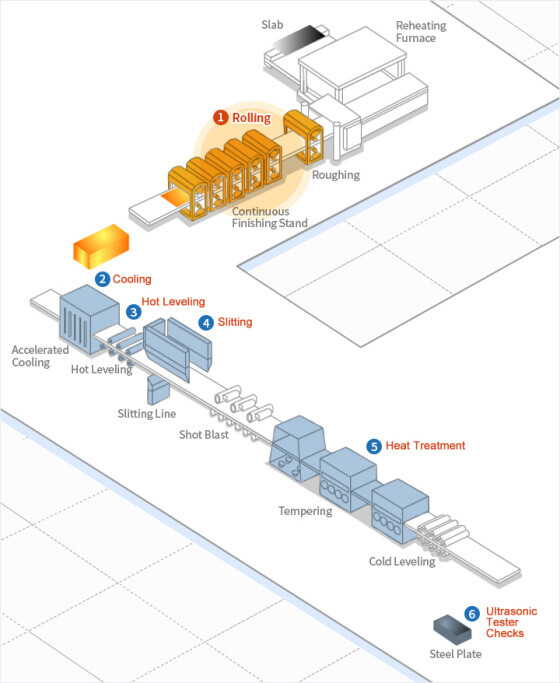- Manufacturing -
 Steel PlateSteel Plate
Steel PlateSteel Plate1. Rolling: The 4-high reversible finishing mill with the maximum load of 7000 tons minimizes internal defects even inly thick plates. Automatic gauge control and shape control systems can reduce not only the thickness deviation of plates but also improve the flatness.
2. Cooling: The cooling system enables the production of high strength steel without heat treatment through rolling and accelerated cooling. Using the mist cooling method with suction type, the system has a high cooling capacity and is able to maintain a uniform temperature gradient in the widthwise direction. This leads to a reduction of plate quality deviation.
3. Hot Leveling: The hot leveler is used to make superior quality flat plates by eliminating residual stress left on rolled plates.
4. Slitting: After passing through the cooler, the plates undergo a dimensional accuracy inspection and then cut into appropriate width and length according to plate grade and thickness using either mechanical shearing machine or flame planner. To obtain a higher degree of dimensional accuracy in products, production conditions are determined by such factors as the air knife gap and the nozzle size of the gas torch.
5. Heat Treatment: To attain the plate structure demanded by customers, plates undergo heat treatment after having the scale removed by shot blasters. The heat treating facilities are of a non-oxidizing radiation tube type, which produces scale-free heat-treated plates.
6. Ultrasonic Tester Checks: The ultrasonic tester checks for blow holes, pipes, and laminations and other internal defects. This test is performed to guarantee the internal quality of plates demanded by customers.More Content Stainless SteelStainless Steel
Stainless SteelStainless Steel1. Steel Making: Steelmaking has the greatest impact on the quality and cost of steel products. We has state-of-the-art AOD, VOD and continuous casting facilities..
2. Hot Rolling: Slabs made in the steelmaking plant are rolled into black coils of highly refined thickness and shape before being made into white coils to the needs of customers through heat treatment, pickling and finishing in the annealing and pickling plant. White coils so produced are used for cold rolling, pipes and sheets.
3. Plates: Slabs produced at the steelmaking plant undergo rolling, heat-treatment and a pickling process, which are then cut into sizes as ordered and delivered to the customer. Thick plates are used by the heavy chemical industries that require corrosion resistance, such as petrochemicals, power plant facilities, paper manufacturing and special shipbuilding.
4.Cold Rolling: JIUZHOU is equipped with 20 high cluster mills, bright annealing line, TLL (Tension Leveling Line), AFC (Automatic Flatness Control), AGC (Automatic Gauge Control), which enable the production of cold rolled products of 0.1-3.0mm in thickness and up to 1580mm in width in various shapes and surface treatment.More Content Hot Rolled Steel
Hot Rolled SteelHot Rolled Steel
1. Reheating: Hot rolled coils pass through a pickling line, where scale breaker machines and hydrochloric acid solutions are used to remove any surface scale and/or oxide film that which causes surface flaws during the final stage of cold rolled steel processing.
2. Roughing: In this process, slabs whose surface scale share has been removed are made into rolled materials with the proper shape, thickness, and width. In the entry and exit area of the roughing mill, an edger rolls the strip in the width direction using an Automatic Width Control (AWC) system.
3. Finishing Rolling: The purpose of finishing rolling is to adjust the thickness and width of a coil to the specified dimensions and to produce a smooth surface and shape at the desired finishing temperature appropriate for its intended use. Our up-to-date equipment, including Work Roll Shift Mills, Pair Cross Mills and On-line Roll Grinders (ORG), enhances plant productivity and improves the quality of the finished coils by controlling the crown shape.
4. Run-Out Table and Coiling: Steel strips, after the finishing mill, are passed to the run-out table where they are coiled. While being rolled on the table, the strips are sprayed with water to cool them to the proper temperature for coiling.More Content

Please give us a message



